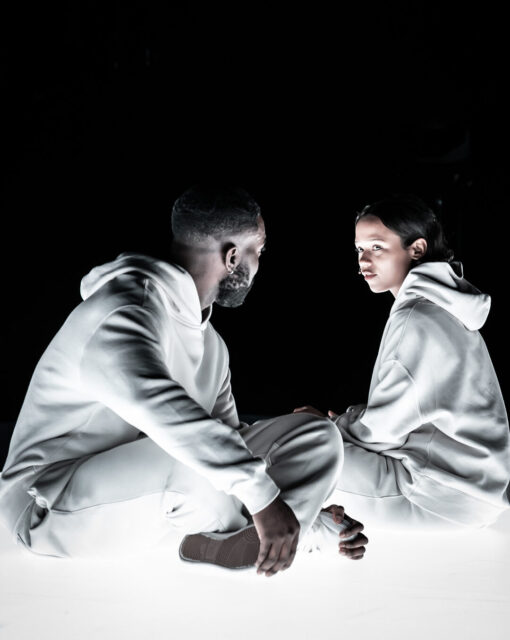
Tristan (Paapa Essiedu) and Connie (Taylor Russell) are part of a pharmaceutical experiment in The Effect (photo by Marc Brenner)
THE EFFECT
The Griffin Theater at the Shed
The Bloomberg Building at Hudson Yards
545 West 30th St. at Eleventh Ave.
Tuesday – Sunday through March 31, $109-$159
646-455-3494
theshed.org
British director Jamie Lloyd has dazzled New York audiences the last five years with stunning revivals of Cyrano de Bergerac at BAM and A Doll’s House and Betrayal on Broadway, starring such big names as James McAvoy, Jessica Chastain, and Tom Hiddleston. His stripped-down versions illuminate the story, giving the actors plenty of room to do what they do best.
Lloyd is now back with Lucy Prebble’s The Effect, but this time his spare staging, though electrifying, is not quite able to cover up the flaws in the repetitive and confusing plot.
The play debuted at the National Theatre in 2012 with Billie Piper and had its New York premiere at the Barrow Street Theatre in 2016. This revival, running at the Shed’s Griffin Theater through March 31, features a narrow rectangular video platform in the center; the audience sits on opposite sides, essentially looking at one another, implicating everyone in the proceedings. The show takes place in a pharmaceutical testing facility where Tristan Frey (Paapa Essiedu) and Connie Hall (Taylor Russell) are the subjects in a four-week study of a new antidepressant; they have agreed to surrender their phones, be honest about what they’re feeling, and abstain from sex.
They are being observed by Dr. Lorna James (Michele Austin), who sits at one end; her ambitious colleague, Dr. Toby Sealey (Kobna Holdbrook-Smith), sits at the other. The subjects are dressed all in white, the doctors all in black. Above them is an exposed flown lighting truss; there are speakers up high as well as behind the two doctors. A distant, ominous drone can be heard throughout the play’s hundred minutes. When the audience first enters the theater, loud EDM is blasting, with smoke floating across the space, as if we’re at a club. The set and costumes are by Soutra Gilmour, with lighting by Jon Clark, music composition by Michael “Mikey J” Asante, sound by George Dennis, and movement direction by Sarah Golding and Yukiko Masui of the SAY dance company.
“Have you ever suffered from depression?” Dr. James asks Connie, who responds, “No. I’ve felt depressed. But. . . . What I mean is, I’ve been sad. . . . Just. I wouldn’t say, oh I’m depressed. Or I would, but just meaning sad. You know cos. That’s. I’m not. So.” The difference between depression and sadness is key to the plot, as Connie and Tristan receive doses of agent RLU37 (or a placebo) and Dr. James measures their heart rate, pupil dilation, electro-dermal response, and blood.
Squares and rectangles light up on the platform, trying to contain Tristan and Connie, but the more time they spend together, the more they want to break the rules, especially Tristan, who has gone through previous drug trials and can’t stop flirting with Connie. Early on, they participate in a test with words and colors that flash on the floor of the platform in such a way that the audience can take the test as well, creating another bond. It could be us onstage, dealing with sadness and depression.
Meanwhile, it becomes apparent that Dr. James and Dr. Sealey have some kind of history that could impact their objectivity as Tristan and Connie try to figure out what is real and what is the result of a chemical reaction. “I can tell the difference between who I am and a side effect,” Tristan says. “With respect, Tristan, no you definitely can’t,” Connie answers.
The Effect is mesmerizing to watch; there is always something going on that will captivate your attention, from pounding beats and flashing lights to billowing smoke and unexpected movement. Austin (The Hunt, Cyrano de Bergerac), Holdbrook-Smith (Tina Turner: The Musical, The Low Road), Essiedu (The Moment Before I Am Powerful, The Convert), and Russell (Bones and All, Waves), in her theatrical debut, are a formidable ensemble, but the narrative feels repetitive in the second half, revisiting ideas it has already covered.
Prebble (A Very Expensive Poison, The Sugar Syndrome), who was a writer and Emmy-winning producer on Succession and the creator of the hilariously cringy show I Hate Suzie, which starred Piper as a former child star enveloped in a sex scandal as an adult, raises fascinating questions about fantasy and reality; personal identity and drug-manufactured social behavior; and humanity’s growing dependence on pharmaceuticals, even as the chemistry between the characters eventually hits a wall.
[Mark Rifkin is a Brooklyn-born, Manhattan-based writer and editor; you can follow him on Substack here.]